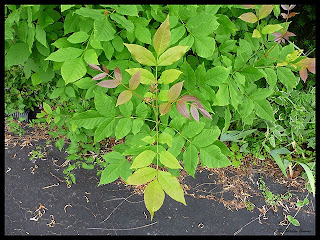One of our kids reacts quite violently to poison ivy to the point of needing emergency medical attention from exposure on several occasions. Most of the contact has come from when we were camping but the other day a large poison ivy plant was discovered in their backyard so called me for advice. That jogged my memory to take another look around the yards to be sure there was no poison ivy.
Poison sumac is a wood shrub that can grow up to 20 ft tall. All parts of the plant contain urushiol that causes skin and mucous membrane irritation in humans. If the plant is burned inhalation of the smoke may cause the rash to appear on the lining of the lungs. This can cause extreme pain and possibly fatal respiratory distress. The leaf consists of 7 to 13 oval to oblong tapering to a sharp point (acuminate) with a wedge-shaped base (cuneate) leaflets per leaf ending in the characteristic 3 leaf pattern. Each leaflet is wavy-edged (undulate) with no hair to fine down-like hair. Poison sumac grows in very wet or flooded soils in the eastern United States and Canada. Some botanists indicate that poison sumac is the most toxic plant species in the US.
We have encountered it before when hiking through boggy areas. The poison sumac is growing in areas that were affected by our previous drainage problems with the largest of the plants growing in an area that routinely floods in the spring or heavy rains. Essentially our paved driveway is higher than the neighbour's yard so our first year here we noticed the water problems. Between the two of us we have been working on the drainage problems on both properties.
Since poison sumac is so toxic we have no choice but to destroy the plants for our own safety. This is one of the few times that Round-up can be used here due to Ontario's pesticide ban. I will wait for a clear, dry day then spray the plants. Once they are dead we will remove them wearing protective clothing and bag them in yard waste bags for the garbage as the dead plants cannot be put in the compost or be burnt.
Happy Gardening!
Garden Gnome
©2006-2010





















0 comments:
Post a Comment
Thanks so much for commenting. Your message will appear once approved.